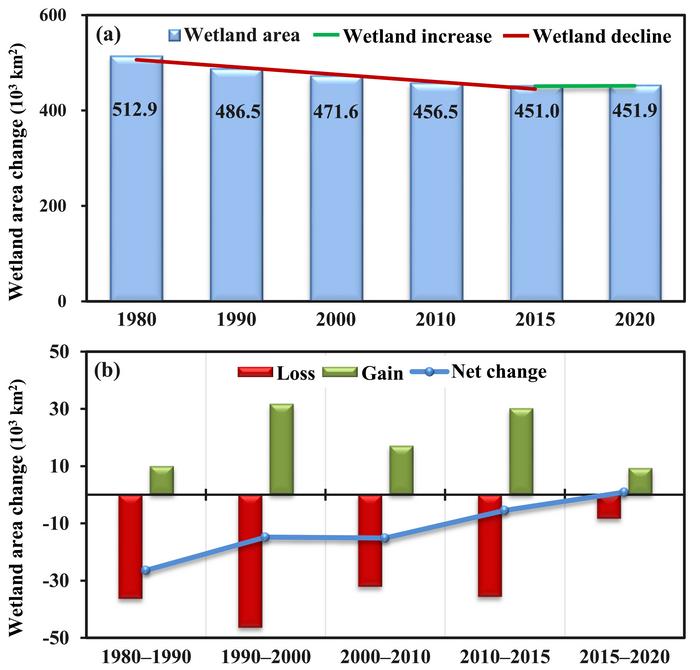In recent decades, the nature of wetlands in China has undergone significant transformation, primarily owing to anthropogenic activities and climate change. A groundbreaking study led by renowned researchers from the Northeast Institute of Geography and Agroecology, Chinese Academy of Sciences, has critically examined the changes in wetland extent from 1980 to 2020. This comprehensive research effort has spanned five years and employed advanced methodologies, ultimately producing the national wetland mapping product, referred to as China_Wetlands, that documents wetland dynamics across six distinct time frames: 1980, 1990, 2000, 2010, 2015, and 2020.
Utilizing over 53,000 scenes captured by Landsat satellites, the researchers adopted a hybrid object-based and hierarchical classification approach, which enabled them to distinguish between various wetland types and assess their changes with precision. The findings reveal a stark narrative of wetland shrinkage, with approximately 60.9 × 10^3 km^2 lost, constituting about 12% of the total wetland area in 1980. This figure underscores the magnitude of wetland decline, which has not only affected biodiversity but also the ecosystem services that these landscapes provide.
Before 2015, the trend of wetland loss was prevalent; however, a modest rebound was observed between 2015 and 2020. This oscillating trajectory of wetland dynamics illustrates a complex interplay between natural systems and human-induced alterations. The study’s authors emphasized that while human-made wetlands contributed to the overall area, they could not wholly compensate for the loss of natural wetlands. Approximately 15.6 × 10^3 km^2 of man-made wetlands were established, yet the loss of associated biodiversity and ecosystem function is profoundly concerning.
Significantly, the research indicates that the expansion of surface water, quantified at around 14.0 × 10^3 km^2, may mask the critical decline of vegetated wetlands. This inflated perception of wetland stability reveals a troubling facet of wetland management—conservation efforts that do not account for the nuanced realities of wetland changes may inadvertently promote unsustainable practices. As Zongming Wang articulated, the push for a ‘zero net loss target’ may be inappropriate for genuinely preserving wetland ecosystems. It underscores the need for a revised understanding of what sustainable wetland conservation should entail in the context of visible losses and hidden transformations.
Beyond the numbers, the implications of wetland loss are far-reaching. Wetlands provide vital ecosystem services, including water purification, flood control, and habitat for both terrestrial and aquatic species. The collapse of these systems due to unchecked habitat degradation threatens not just flora and fauna but also the communities relying on wetlands for their livelihood and wellbeing. Thus, the study advocates for an integrative management approach that emphasizes not only the maintenance of wetland areas but also the safeguarding of ecosystem integrity.
The recommendations from the study’s co-authors resonate with the fervor of preservationists in the field. They call for enhanced protective measures that include ecological restoration projects, better-informed management systems, and a commitment to assess future climate-related changes comprehensively. The control of invasive species and sensibility towards the transformations within wetland types further underscore the importance of maintaining the ecological balance.
The significance of the China_Wetlands dataset cannot be overstated. It stands as an indispensable resource for ecological research, with insights that will inform both national and global environmental policies. Scholars and researchers have already expressed enthusiasm for utilizing the dataset in various studies, reinforcing its role as a cornerstone for future wetland research.
Research leaders like Professor Dehua Mao have emphasized the importance of sharing this pivotal dataset with the academic community. The collaborative endeavor involved in creating China_Wetlands represents a significant stride towards understanding the broader implications of wetland losses and gains across China. As such, it reinforces the interplay between scientific inquiry and policymaking.
It is crucial that we remain vigilant about the critical messages emerging from this research. The biodiversity it seeks to protect is not only a variety of species but the intricate relationships they nurture, which are invaluable for ecosystems’ resilience. Efforts to cultivate more sustainable landscapes will require ongoing collaboration across disciplines, including ecology, urban planning, and social sciences, to align conservation goals with practical action plans.
The call to action articulated by the researchers is a vital reminder of humanity’s role in shaping ecological futures. The transformations witnessed in China’s wetlands offer a microcosm for larger global challenges—biodiversity loss, climate adaptation, and ecosystem services provision. As societies grapple with these issues, tools like the China_Wetlands dataset will be indispensable for crafting effective interventions and realizing sustainable ecological visions.
In summary, the trajectory of Chinese wetlands from 1980 to 2020 unveils a narrative of caution and urgency. With the pressing need to reevaluate our strategies for conservation and management, this research not only enhances our understanding of wetland dynamics but also sets the stage for future discourse among scientists, policymakers, and conservationists alike.
Subject of Research: Changes in the extent of Chinese wetlands from 1980 to 2020
Article Title: The trajectory of wetland change in China between 1980 and 2020: Hidden loss and restoration effects
News Publication Date: 12 December 2024
Web References: http://dx.doi.org/10.1016/j.scib.2024.12.016
References: Science Bulletin (Journal)
Image Credits: ©Science China Press
Keywords: wetlands, biodiversity, climate change, natural resources, environmental policy, ecological management.




